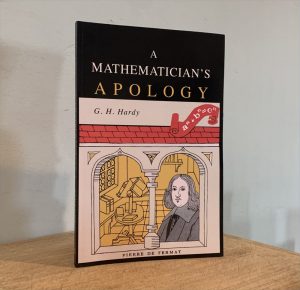In perusing some of the earliest popular books I read about mathematics, including the ones I’ve blogged about here by George Gamow and Krasner & Newman, and then searching around for any other popular mathematical texts from the early 20th century that I had missed, I saw references to this item by one G.H. Hardy, a professor at Cambridge University. It struck me as curious for its title: what is there about mathematics that needs apologizing for?
 I found a new edition on Amazon from Martino Fine Books in Eastford, CT, 2018. It’s 93 pages of very large type. See photos above. The book is the size of a typical modern hardcover. It’s an essay.
I found a new edition on Amazon from Martino Fine Books in Eastford, CT, 2018. It’s 93 pages of very large type. See photos above. The book is the size of a typical modern hardcover. It’s an essay.
I’ll summarize major points bullet-style
- Hardy is apologizing for mathematics as a field of study worthy of a grown man’s career. [[ Yes everyone is men in 1940. ]] Basically on the grounds that it’s so abstract as to be – with the exception of the “school” mathematics that powers science and engineering – useless. [[ Rather like parents who, preferring their children to study law or medicine, dismiss anything else but especially the arts as the road to penury. ]]
- He thinks critics, and people who write popularizations of science for the public, are lesser minds than true scientists and mathematicians. [[ This has been a common criticism for decades, though has gradually faded what with the advent of unquestionably major scientists – beginning with Hawking, perhaps – writing popular books. Sagan was dismissed this way. Not so much, these days, Wilson, or Pinker, or Greene. ]]
- He notes that mathematics, especially, is a young man’s game, with examples: Newton, Galois, Ramanujan. [[ Remember Hardy was the one who basically “discovered” Ramanujan and brought him to Cambridge. ]]
- Trivial point: he cites people who were apparently well-known figures of the time by their last names only, e.g. as we still do Einstein. But also, Houseman (the poet?), Bradley (who?), and others.
- He addresses two questions separately: is math worth doing? And why study it in any case? (He always says ‘mathematics’ but I’m using the short form here.)
- A key defense is that math is permanent; a discovery in math remains true forever. And a major discovery attaches your name to it, forever.
- Hardy is keen on the idea that math – a discovery of patterns, patterns of ideas – should be both serious, and beautiful. Chess, e.g., though a kind of math, is unimportant. Serious means significant meaning that can be connected to other mathematical ideas.
- He gives two simple examples of mathematical theorems that are first rate. First, the existence of an infinity of prime numbers; second, the irrationality of the square root of 2. Aesthetically, such theorems involve unexpectedness, inevitability, and economy.
- He goes on to distinguish ‘elementary’ (or ‘school’) math with ‘real’ math, the latter being almost wholly useless.
- He contrasts pure and applied math, and wonders whether math exists independently of our minds [[ the idea of discovery or invention, as I discussed before ]] and believes it lies outside us.
- He concedes that some higher math, like matrices and group theory, may yet become ‘useful’, perhaps in modern physics. (See my comment below.)
- Finally, there are two mathematics: real, and ‘school’. The former is justifiable only as art.
- At the same time, concluding as he does writing in 1940, he concedes that school math has many applications in time of war, in the invention of weapons, and aeroplanes.
- And he ends with a very brief autobiography. Once he discovered math, he never wanted to do anything else. And he feels he’s led a worthy life.
My comments:
- First, I don’t think there’s any kind of popular resistance to the study of math today that would require this kind of apology.
- Second, he’s correct in anticipating that some fields of abstruse ‘real’ (or higher) math turn out to be useful, as various writers (e.g. the string theorists) have noted again and again.
- And Third, he’s a bit idealistic, and antiquated, in insisting that mathematical truths should be ‘beautiful.’ There have been books about this idea, especially as it applies to physics (again string theory). But a counter-example is Wiles’s proof of Fermat’s Last Theorem, a great achievement in 1993, but hardly beautiful.
So is everything true, beautiful? No. Is everything beautiful, true? Hmm. I’m guessing not.






